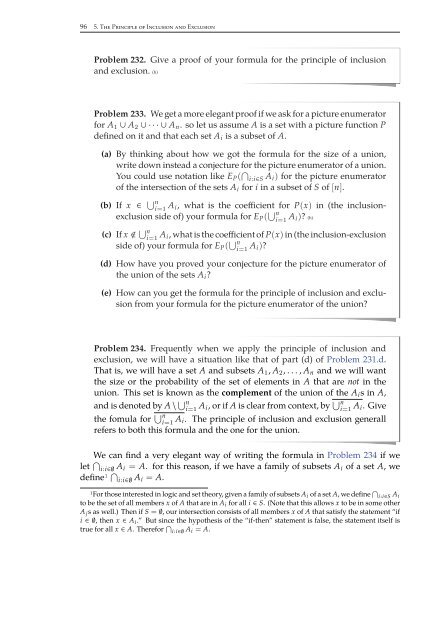Combinatorics Through Guided Discovery, 2004a
Combinatorics Through Guided Discovery, 2004a
Combinatorics Through Guided Discovery, 2004a
Create successful ePaper yourself
Turn your PDF publications into a flip-book with our unique Google optimized e-Paper software.
96 5. The Principle of Inclusion and Exclusion<br />
Problem 232. Give a proof of your formula for the principle of inclusion<br />
and exclusion. (h)<br />
Problem 233. We get a more elegant proof if we ask for a picture enumerator<br />
for A 1 ∪ A 2 ∪···∪A n . so let us assume A is a set with a picture function P<br />
defined on it and that each set A i is a subset of A.<br />
(a) By thinking about how we got the formula for the size of a union,<br />
write down instead a conjecture for the picture enumerator of a union.<br />
You could use notation like E P ( ⋂ i:i∈S A i ) for the picture enumerator<br />
of the intersection of the sets A i for i in a subset of S of [n].<br />
(b) If x ∈ ⋃ n<br />
i=1 A i, what is the coefficient for P(x) in (the inclusionexclusion<br />
side of) your formula for E P ( ⋃ n<br />
i=1 A i)? (h)<br />
(c) If x ⋃ n<br />
i=1 A i, what is the coefficient of P(x) in (the inclusion-exclusion<br />
side of) your formula for E P ( ⋃ n<br />
i=1 A i)?<br />
(d) How have you proved your conjecture for the picture enumerator of<br />
the union of the sets A i ?<br />
(e) How can you get the formula for the principle of inclusion and exclusion<br />
from your formula for the picture enumerator of the union?<br />
Problem 234. Frequently when we apply the principle of inclusion and<br />
exclusion, we will have a situation like that of part (d) of Problem 231.d.<br />
That is, we will have a set A and subsets A 1 , A 2 ,...,A n and we will want<br />
the size or the probability of the set of elements in A that are not in the<br />
union. This set is known as the complement of the union of the A i sinA,<br />
and is denoted by A \ ⋃ n<br />
i=1 A i,orifA is clear from context, by ⋃ n<br />
i=1 A i. Give<br />
the fomula for ⋃ n<br />
i=1 A i. The principle of inclusion and exclusion generall<br />
refers to both this formula and the one for the union.<br />
We can find a very elegant way of writing the formula in Problem 234 if we<br />
let ⋂ i:i∈∅ A i = A. for this reason, if we have a family of subsets A i of a set A, we<br />
define1 ⋂ i:i∈∅ A i = A.<br />
1For those interested in logic and set theory, given a family of subsets A i of a set A, we define ⋂ i:i∈S A i<br />
to be the set of all members x of A that are in A i for all i ∈ S. (Note that this allows x to be in some other<br />
A j s as well.) Then if S = ∅, our intersection consists of all members x of A that satisfy the statement “if<br />
i ∈∅, then x ∈ A i .” But since the hypothesis of the “if-then” statement is false, the statement itself is<br />
true for all x ∈ A. Therefor ⋂ i:i∈∅ A i = A.


















